Hidden in a quiet Mid-City tract is a Los Angeles art institution. Not that you’d know it if you didn’t slow down and really look for the five-lot compound on this quiet residential street. Otherwise you could easily miss the sign: “St. Elmo Village,” half hidden by the lush shrubbery. And yet “The Village” is certainly an institution by virtue of its 51 years as a community arts center. A creativity factory far from the mainstream galleries around the city, it is a place imagined and willed into existence by the passion of two men: The late Rozzell Sykes and his then 18-year-old nephew Roderick, who came out from the Midwest in the ’60s. Both painters, they would transform their early live-in studios into a unique compound that has stood as a beacon for African Americans and other artists for a half century.
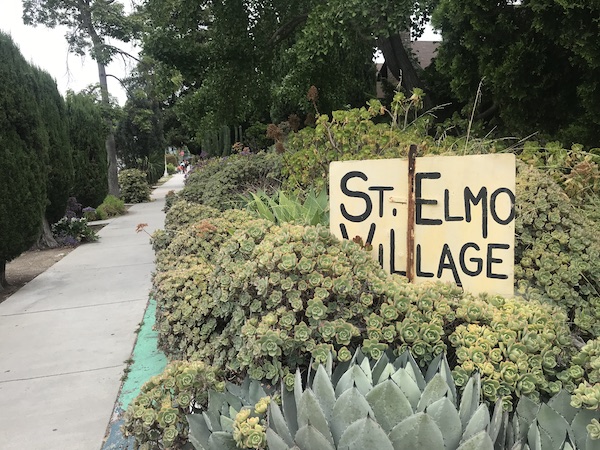
St. Elmo Village Sign
The driving force behind St. Elmo today is Jackie Sykes, painter and photographer (who specifies, “I prefer visual artist.”), Roderick’s wife of 40 years and as resolute as she is diminutive.
“They [Rozzell and Roderick] happened to be artists—and they would take their paintings to Hollywood. They were both from St. Louis and their background was ‘you clean where you live,’ you don’t wait for the landlord to do it. There were old cars and motors and junk— they used some of it to make art… they started to fix the place up.”
The owner, for one, was impressed with the improvements and put the property up for sale. The Sykes made a bid for the lots. The asking price was $60,000 and the men raised the down payment by holding the first “Festival of Creative Survival.”
Eventually they incorporated as a nonprofit thanks to the philanthropy of early patrons—Wally Amos of the famous cookies, TV producer Don Brinkley and other Hollywood types that had bought Sykes’ work (an early friend that still shows up is Jeff Bridges). They received political support from the likes of Senator John Tunney and Mayor Tom Bradley.
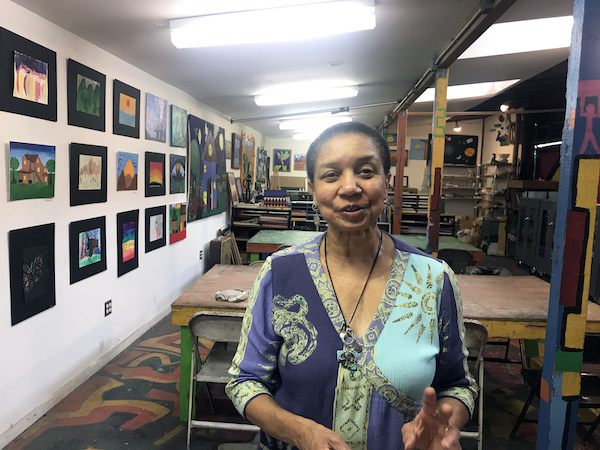
Jackie Sykes
“This was after the ’65 riots, so just like now there was a push to help disadvantaged communities—just like in ’92,” recalls Jackie today.
Maybe that’s what accounts for the feeling of a ’60s intentional community that still lingers at St. Elmo. When you step into the garden you float on a multi-hued flying carpet (“largest ground mural in the U.S., I believe,” says Jackie). It connects 10 structures—small California bungalows that in the ’20s were part of Mary Pickford’s horse farm—when this part of town, close to Rimpau and Venice Boulevards, was the prairie-like western edge of the city. Later the shacks were used as living quarters for farm laborers.
Today they house the free workshops in drawing and painting for young children, photography and computer graphics for older ones and adult pottery and clay. (The latter are still ongoing, with distancing; the kids, hopefully, will be back in the fall). There’s also an Arts and Music Library and a community meeting room. Some units and apartments in the adjacent building (acquired in the ’90s) are rented as a source of income. “You can stay here like a residency for six months to a year,” says Jackie, “as long as you share what you do with the community and with us.”
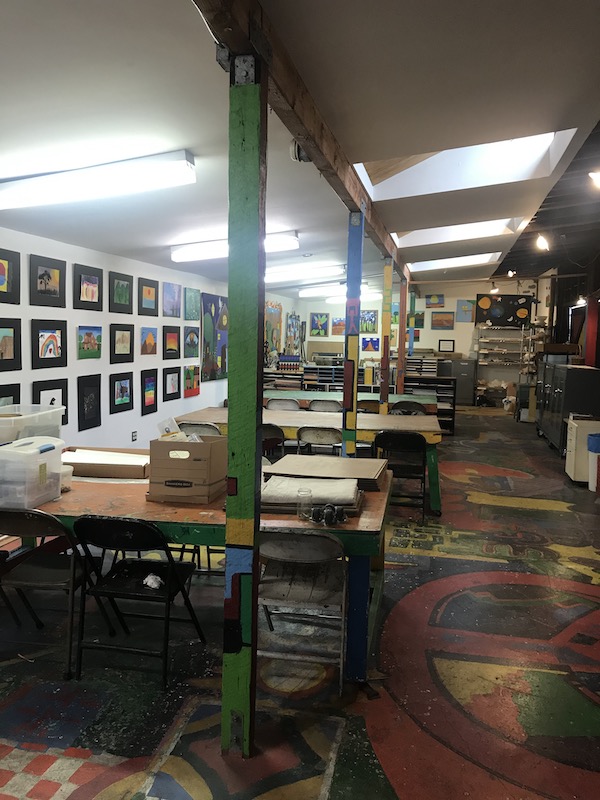
Workshop studio
Through the years these “flats” below the stately mansions of Lafayette Square and Victoria Park became a Black and Brown working-class neighborhood, one of those largely forgotten by all but those who lived here in the segregated plains of LA, “invisible” to the cultural establishment. But The Village never ceased its work even as social upheaval ebbed and flowed around it in waves.
“In the ’80s it was horrible. There was a crack house over here, a crack house over there… we were surrounded. And we called them zombies; they would come out at night. We told a lot of our neighbors, if you hang in there and if you’re part of the solution, stick together, we can get through this.” Today, as in so many other neighborhoods, the prevailing dynamic is gentrification. “We see people walking their dogs and running down the street like they’re at the beach… but it’s fine. The rent hikes are not so positive but then we get a Lowe’s, we get Smart&Final, shopping services that we needed for years.”
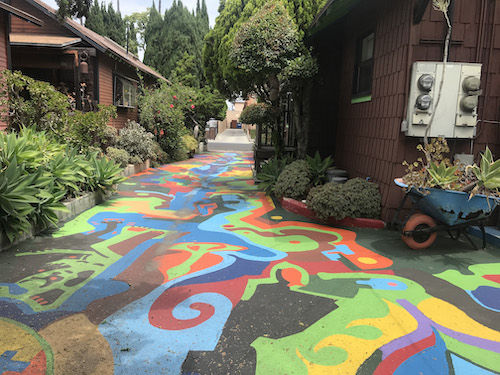
St. Elmo Village entrance with the floor mural
St. Elmo has not had an overtly social or political agenda. Lately however, The Village has been in the news through its association with Black Lives Matter. Melina
Abdullah, who co-founded the LA chapter of BLM, among others, has told the story of the group’s constitution following a meeting here after the Trayvon Martin outrage. Artist and prison-rights activist Patrice Khan Cullors was instrumental in organizing it.
“When BLM first got started it was just basically a group of people that needed a place to be and to organize, and we were here. And Patrice lived here so she asked Roderick,and they had several [meetings] here. It’s a safe space. You feel comfortable; you can let your shoulders down, relax and breathe. And we take pride in being that space.”
A yearly jazz and blues festival is still held, as well as drum circles. Workshop kids have grown and returned as teachers. Paintings hang on the walls and Literacy, the SPARC-sponsored mural recreated by Roderick after it was destroyed at the original location (a nearby LAUSD maintenance yard) faces the street. Overall there is the sense of place, reminiscent of those created by Simon Rodia at the Watts Towers or Noah Purifoy’s desert ranch. The feeling of a “hand made” place which is the sum of the art the villagers have produced—like those other places, it is itself the very site-specific artwork.
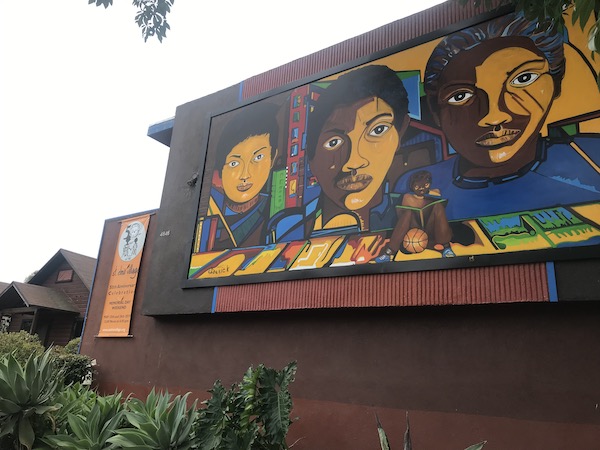
Roderick Sykes, Literacy
“We’re a lot of circles that intertwine. We’re not just in the ‘art organization’ box,” Jackie explains. “We’re a polling place, the police come here, we have a relationship with the fire department. The gang members respect The Village, so socially we connect all the dots together so that people feel comfortable here, no matter what your walk of life is.
“[Art] can save your life. There’s a creative process to everything we do and once we acknowledge that and use that in a positive way then we grow and we succeed. It’s really very simple, there’s nothing complex about it.”
“It’s all a combination of what Roderick and Rozzell started,” Jackie concludes. “It’s my job now to continue.”





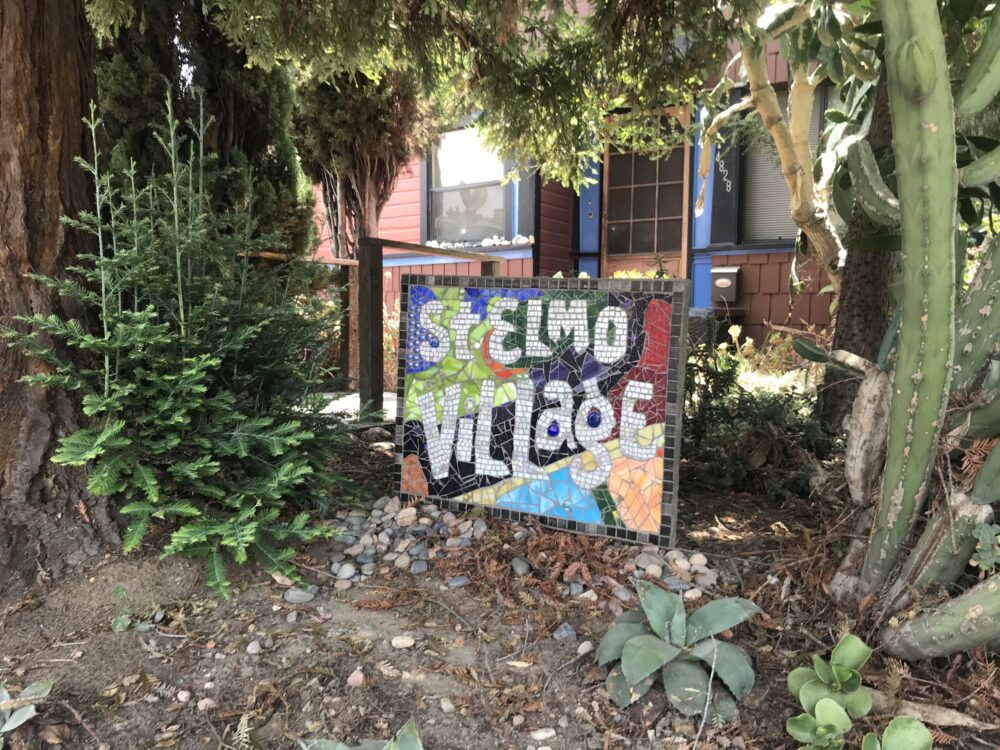













0 Comments